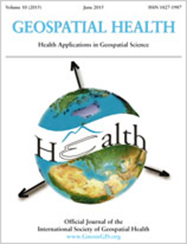The utility of Google Trends for epidemiological research: Lyme disease as an example
Published: 1 May 2010
Abstract Views: 9838
PDF: 3463
Publisher's note
All claims expressed in this article are solely those of the authors and do not necessarily represent those of their affiliated organizations, or those of the publisher, the editors and the reviewers. Any product that may be evaluated in this article or claim that may be made by its manufacturer is not guaranteed or endorsed by the publisher.
All claims expressed in this article are solely those of the authors and do not necessarily represent those of their affiliated organizations, or those of the publisher, the editors and the reviewers. Any product that may be evaluated in this article or claim that may be made by its manufacturer is not guaranteed or endorsed by the publisher.
Similar Articles
- Benn Sartorius, Kathleen Kahn, Mark A. Collinson, Penelope Vounatsou, Stephen M. Tollman, Survived infancy but still vulnerable: spatial-temporal trends and risk factors for child mortality in the Agincourt rural sub-district, South Africa, 1992-2007 , Geospatial Health: Vol. 5 No. 2 (2011)
- Desmond H. Foley, Richard C. Wilkerson, L. Lynnette Dornak, David B. Pecor, Arpad S. Nyari, Leopoldo M. Rueda, Lewis S. Long, Jason H. Richardson, SandflyMap: leveraging spatial data on sand fly vector distribution for disease risk assessments , Geospatial Health: Vol. 6 No. 3 (2012)
- Josh Colston, The neglected tropical diseases (NTD) initiative for Latin America and the Caribbean of the Inter-American Development Bank and the role of geospatial analysis in health programmes , Geospatial Health: Vol. 6 No. 3 (2012)
- Steven K. Ault, Ruben Santiago Nicholls, Martha IdaIí Saboya, The Pan American Health Organization's role and perspectives on the mapping and modeling of the neglected tropical diseases in Latin America and the Caribbean: an overview , Geospatial Health: Vol. 6 No. 3 (2012)
- John B. Malone, N. Robert Bergquist, Mapping and modelling neglected tropical diseases and poverty in Latin America and the Caribbean , Geospatial Health: Vol. 6 No. 3 (2012)
- Samuel F. Atkinson, Sahotra Sarkar, Aldo Aviña, Jim A. Schuermann, Phillip Williamson, Modelling spatial concordance between Rocky Mountain spotted fever disease incidence and habitat probability of its vector Dermacentor variabilis (American dog tick) , Geospatial Health: Vol. 7 No. 1 (2012)
- Jin-Feng Wang, Cheng-Dong Xu, Shi-Lu Tong, Hong-Yan Chen, Wei-Zhong Yang, Spatial dynamic patterns of hand-foot-mouth disease in the People's Republic of China , Geospatial Health: Vol. 7 No. 2 (2013)
- Marilyn O'Hara Ruiz, Amy C. Kelly, William M. Brown, Jan E. Novakofski, Nohra E. Mateus-Pinilla, Influence of landscape factors and management decisions on spatial and temporal patterns of the transmission of chronic wasting disease in white-tailed deer , Geospatial Health: Vol. 8 No. 1 (2013)
- Nicolai Denzin, Joachim Borgwardt, Conrad Freuling, Thomas Müller, Spatio-temporal analysis of the progression of Aujeszky's disease virus infection in wild boar of Saxony-Anhalt, Germany , Geospatial Health: Vol. 8 No. 1 (2013)
- Vitomir Djokić, Ivana Klun, Vincenzo Musella, Laura Rinaldi, Giuseppe Cringoli, Smaragda Sotiraki, Olgica Djurković-Djaković, Spatial epidemiology of Toxoplasma gondii infection in goats in Serbia , Geospatial Health: Vol. 8 No. 2 (2014)
You may also start an advanced similarity search for this article.











